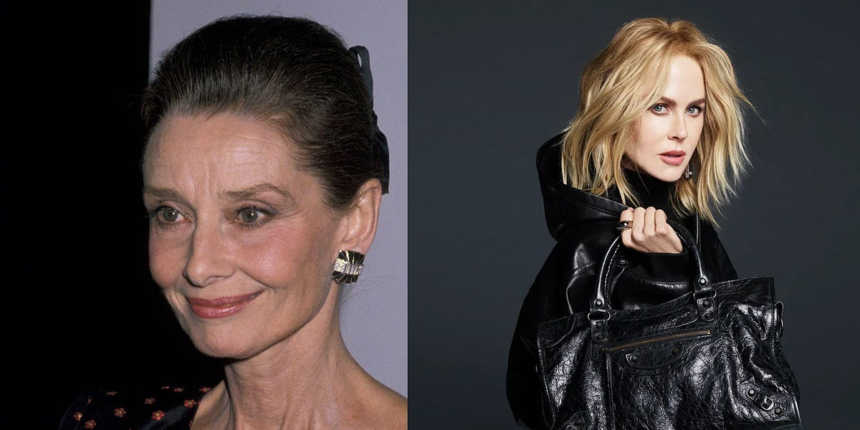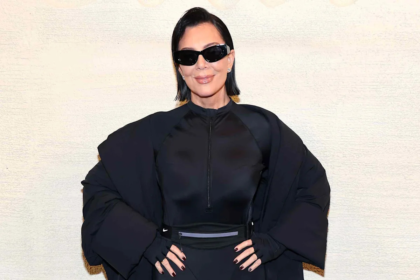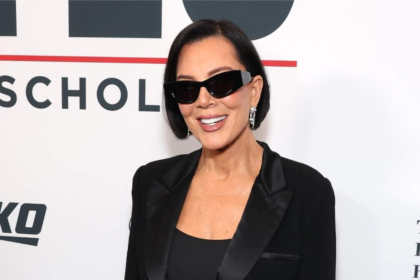France is poised to pass legislation that would regulate ultra-fast fashion by taxing each item €5 (increasing to €10 by 2030). The bill, which passed the French Senate with all but one vote and heads to another vote by a joint committee in September, would also ban the advertising of ultra-fashion fashion, including by influencers.
The New York Times covered a new study on what makes a person seem “cool,” reporting, “Cool people are largely perceived to be extroverted, hedonistic, powerful, adventurous, open and autonomous.”
Meghan Markle’s As Ever brand launched rosé this week. I previously interviewed branding expert
about how she can make a brand work and, well, rosé didn’t come up.
How are we feeling about the new Marc Jacobs fashion show?
Condé Nast put out a call for applicants for the position of head of editorial content for American Vogue, replacing Anna Wintour, on LinkedIn.
And now, onto today’s big story…
After Anne Hathaway attended the Ralph Lauren show in April with a high ponytail, her face glowing and taut, content started going viral about what kind of plastic surgery or cosmetic procedures she may have had. The tone was largely celebratory (“she looks like the princess of Genovia” “…she is proof that aesthetic work can be undetectable and keep you looking like your best self!”). Not long after that, something similar happened to Kris Jenner, whom the internet guessed had had a facelift (“Kris Jenner is giving lifted, snatched, and strategically maintained 🔥”). While Hathaway stayed silent about what she may have had done, Jenner admitted to having had what People called “aesthetic enhancements” by Dr. Steven Levine. Levine gave an interview to the New York Times in 2022 for a story about soaring costs of plastic surgery, which reported that he charges $50,000 to $110,000 for “a face, brow and neck lift, plus lower and upper eyelids.” However, facelifts can easily cost up to $200,000.
Back Row is a reader-supported publication. To receive new posts and support my work, consider becoming a free or paid subscriber.
It’s not just celebrities. All over social media, surgeons and patients are showing off the work they do or have had done, to what are often gushingly positive comment sections. Positive public sentiment surely had something to do with Khloe Kardashian recently releasing a list of her cosmetic procedures.
While it seems good that we’re no longer indiscriminately trashing women for getting facelifts or Botox in one breath and criticizing those who look “old” in the next, the obsession over all this work has started to feel uncomfortably excessive. And it’s not like this is a judgement-free zone: while the masses are celebrating women like Jenner, they’re also attacking women like Lauren Sánchez for what looks like overzealous use of fillers.
To get a temperature read on this confusing moment, I reached out to my friend and veteran beauty journalist
, who writes the wonderful Substack How Not to F*ck Up Your Face. Her newsletter answers reader questions about procedures and products without trying to sell them anything. I love Val’s writing because it’s loaded with expertise, but also, because it meets me where I’m at, as a nearly 40-year-old who feels both interested in and overwhelmed by various treatment options out there, without judgment. And I can tell by the letters she responds to each week that her readers feel the same way. Ahead, our conversation about what it means that plastic surgery is an inescapable part of culture.
I can’t seem to open social media without seeing speculation — or celebration — over what procedures people like Anne Hathaway or Kris Jenner have had. What do you make of this?
With somebody like Anne Hathaway, it looks like maybe she’s had plastic surgery or maybe she hasn’t: You just don’t know. Kris Jenner supposedly looks fabulous, but we have no idea what she really looks like without the team of magicians who work on all of these celebrities before they appear in public. There was a video of Kris after she’d had several facelifts when she was selling Kim’s skincare line S-K-K-N.
She takes off her makeup and she looks like a fairly well lived-in, well-preserved sixtysomething — but completely different from what she looks like in her social media posts.
We need to be aware that what we see on social media is a fiction. These beauty standards don’t exist in real life. I think most people are completely unaware of that. These filtered images promoting unachievable beauty standards have been shown to result in an uptick in plastic surgery procedures. So there’s lots of reasons why scrolling through the endless feed of before-and-afters and celebrity photos is really bad for us. It leads to mental fatigue.
I feel like I was experiencing that in an extreme way recently. I don’t care what these stars are doing — let them do it — but I just didn’t want to see so much of it every single day.
Yet it is very hard to stop scrolling because it feels addictive. And it also results potentially in a kind of emotional distress. I think it can lead to depression when you’re looking at photos that foster unrealistic expectations about what surgical outcomes can do for you. You may be feeling more dissatisfied with the way you actually look, and then feeling anxious about it, and then wanting something to be done about it. But the whole thing — your dissatisfaction — is based on something that’s not actually real.
I find it depressing that we’re taught to partake in capitalism, and then it’s like, well, why? So that we can be like Kris Jenner and get a $200,000 facelift when we’re in our sixties?
We don’t have access to the kind of money Kris Jenner and these celebrities have. But maybe their work is being comped, who knows? And then there’s a class issue, separating those who can [get work done] and those who can’t, and those who can’t, suffering from an imagined reduction in our potential.
The capitalism issue — everything we see basically on social media vis-a-vis appearance is rooted in marketing. Somebody always wants us to buy something.
Did you see the before-and-afters of Lauren Sánchez floating around? I’m not sure if those are real or photoshopped, but what do you make of villainizing some women for getting work done while applauding others for doing the same?
I did see some of the photos of Sánchez. The ones that showed how big her lips are did seem to be [edited] in some way. But on the other hand, in many of the potentially unfiltered photos I’ve seen, she looks like she’s just had unrestrained filler in her face, maybe surgeries. If there is such a thing as reality in these photos, some people have actually had terrible work done, or they’ve had too much filler. Whereas with Kris, as I said, we really don’t know what she looks like, but whoever is putting her together — her character, basically — is more sophisticated.
I’m predisposed not to like Sánchez because of who she’s attached to and what her values seem to be. But she presents as overly feminized, to the point of caricature. I think that may be what we’re responding to. When I looked at some of the more curated photos of Kris, she actually looks like a 12- or 14-year-old anime character, with a little kittenish hairdo and the big eyes and baby-ish face.
I found The Cut’s article about filler from 2023 to be absolutely haunting. What’s your take on filler?
I never suggest people get filler. When somebody injects you with filler, you don’t know how or where they’ve been trained or how sophisticated their aesthetic eye is, and filler is easy to fuck up.
Good injectors have told me you don’t really use filler to fill the face. You use it to basically play with the planes of the face so that when light hits in different ways, it makes the face look more proportioned, or more youthful.
I’ve had filler twice. I have those little vertical lines above my upper lip, called smoker’s lines (or perioral rhytides). I’ve tried to have them filled, and then I had a little area injected in my chin. And what I wound up with was a huge bruise and nothing else both times.
Is it true that you have to keep getting filler in order for it to work?
Well, that’s the problem. I keep saying, there’s no fountain of youth, there’s only a fountain of different. At some point, you’re going to have to stop doing filler and start to consider surgery because filler can only do so much. Some people get to a certain point and then they just start to look a little off. When somebody doesn’t look quite right, it’s usually, I think, because of misuse of filler.
You and I were looking at one social media post where an influencer of sorts had shared all the procedures they had had done and the list was sort of shocking, how long it was.
I sent it to a dermatologist. I was like, how many procedures could she have done in a year? It seems kind of impossible. And she said, “Of course she could have had all this done and continue to do it every year, because some doctors will just keep doing anything.”
I see this anecdotally. I know a woman who had a facelift a few years ago, and she’s constantly looking in the mirror to see what else she can do. She will go to one doctor after another who will suggest different procedures. And does she need them?
Does anybody? I was looking at photos of Audrey Hepburn. She died at 63 years old, but it is really astonishing to look at a celebrity who aged before all of this stuff existed the way it does today. Our eye has been altered to expect these celebrities to look like fiftysomething Nicole Kidman versus fiftysomething Audrey Hepburn.
Putting aside the issue that the idealized images are not really what they look like, there’s this kind of inhuman, consistently clean, kind of AI version of people that we’re becoming more and more used to. Which is very scary, because we’re leaning toward a kind of unachievable perfection that is so dismissive and destructive to our actual existence. We’re mortal! These images make us believe, on some level, that these people, like Kidman or the Jenners, are not actually aging, when we are.
When Martha Stewart was on the cover of the Sports Illustrated Swimsuit issue, she claimed that that photo was hardly retouched at all. And of course, it was retouched. I don’t know about her face, but certainly her body. And it made me think, are she and the people who project these images trying to make us believe that they’ve got eternal life? Do they believe it? I think it all ties into the marketing of the longevity movement. It’s already true that people with less money die sooner than the rich.
I believe it’s much healthier spiritually to learn how to live in a body that doesn’t last forever. If we live to be 120, we’re just going to want to look like we’re 50 or 60 until we’re 120. When we look at older people, it reminds us that we are not permanent. When [aging] actually does start to happen to us, it reminds us that the runway has shortened. For many people, the first thing we think of is trying to make that thought go away.
What do you make of young people getting procedures done? I see people who look to be in their twenties or early thirties having eyelid surgery and showing off their results online. Nikki Glaser has a standup bit floating around social media where she’s joking about her eyelids looking like the curtains behind her. It makes me laugh but also, it’s like, really? She’s 41 (she was 39 when she made that joke).
It’s true that if you start injecting in your thirties, you never develop the deep wrinkles that might come from the muscle movements that cause wrinkles as you get older. On the other hand, we don’t really know what effect paralyzing the muscles in your face for 30 years is going to have on your physiognomy. (I’ve read that when you get older, it’s not a good idea to try to get rid of all the wrinkles with a neuromodulator in your forehead because it causes the brow to drop.) Trying to prevent any signs of aging, number one, is impossible. And number two, I think it’s spiritually kind of rotten.
I wish people could understand the effect of protecting your skin from the sun as you age — daily sunscreen, reapplication, and being super-careful about shading your skin from the sun. People say, well, we need vitamin D. You get enough vitamin D if you give yourself a little bit of exposure every day.
Something like 93 percent of the damage in your skin comes from sun exposure. And if you look at your ass, if you haven’t been sunbathing nude, and look at your face, you can see what the skin on your face would look like if you never exposed it to the sun. It really, really makes a huge difference. And it’s just incredible to me that people are much more willing to go to a plastic surgeon than they are to be consistent about wearing sunscreen.
We don’t see a comparison of a sun-exposed face versus someone who’s avoided it as often as we see the plastic surgery before-and-afters.
There’s this famous photo of twins, and one of them looks like a dried-up apple and the other one looks like she’d had years of plastic surgery. It’s pretty impressive.
Do you have a favorite daily sunscreen?
I’ve had a basal cell skin cancer on my cheek and on one of my arms, so I’m using something that’s got DNA repair in it. I’m now recommending that because there have been studies that have shown that these DNA repair lotions actually work well to help prevent the skin from producing the cells that develop into skin cancer. I use ISDIN Eryfotona Actinica sunscreen. At night, I use Neova total repair. I also alternate between the Neutrogena collagen bank moisturizer SPF30 and the Neutrogena retinol moisturizer SPF30. During the day, if I’m out and about, I reapply with a Colorescience powder sunscreen on top. I like the way it looks on my skin. And at the beach, I wear an SPF 50 and a hat.
Don’t forget Subscribe to Val’s newsletter, How Not to F*ck Up Your Face.
Back Row is a reader-supported publication. To receive new posts and support my work, consider becoming a free or paid subscriber.
I just want to age like Audrey.
Great piece, Amy – so well-balanced.
Re neuromodulators – my husband studies spinal cord injury, including treatment using neuromodulators like Botox. What Valerie says about your brow dropping after years of use is true – because neuromodulators essentially kill the muscle over time. He says it will be interesting to see what happens to these young people who begin using Botox at 25 and will then have issues around 40.
Also, how beautiful is Audrey Hepburn at 60!
No posts
Ready for more?









